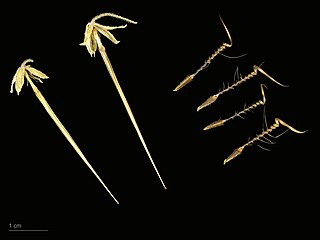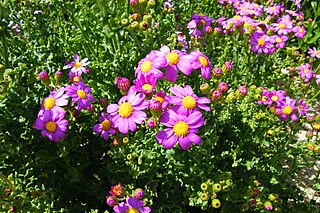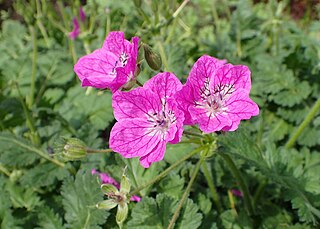
Dysphania botrys, the Jerusalem oak goosefoot, sticky goosefoot or feathered geranium, is a flowering plant in the genus Dysphania. It is native to the Mediterranean region.

Erodium is a genus of flowering plants in the botanical family Geraniaceae. The genus includes about 60 species, native to North Africa, Indomalaya, the Middle East, and Australia. They are perennials, annuals, or subshrubs, with five-petalled flowers in shades of white, pink, and purple, that strongly resemble the better-known Geranium (cranesbill). Cultivated plants are known as filarees or heron's bill in North America, whereas in the British Isles they are usually called storksbills.

Erodium texanum, also known as Texas filaree, Texas stork's bill, or heronbill, is a flowering plant which is native to the southwestern United States and northern Mexico. It is an annual or biennial herb.

Erodium cicutarium, also known as common stork's-bill, redstem filaree, redstem stork's bill or pinweed, is a herbaceous annual – or in warm climates, biennial – member of the family Geraniaceae of flowering plants. It is native to Macaronesia, temperate Eurasia and north and northeast Africa, and was introduced to North America in the eighteenth century, where it has since become naturalized, particularly of the deserts and arid grasslands of the southwestern United States.

Erodium malacoides is a species of flowering plant in the geranium family known by the common names Mediterranean stork's bill, soft stork's-bill and oval heron's bill. This is an annual or biennial herb which is native to much of Eurasia and North Africa but can be found on most continents where it is an introduced species.

Erodium moschatum is a species of flowering plant in the geranium family known by the common names musk stork's-bill and whitestem filaree. This is a weedy annual or biennial herb which is native to much of Eurasia and North Africa but can be found on most continents where it is an introduced species. The young plant starts with a flat rosette of compound leaves, each leaf up to 15 centimeters long with many oval-shaped highly lobed and toothed leaflets along a central vein which is hairy, white, and stemlike. The plant grows to a maximum of about half a meter in height with plentiful fuzzy green foliage. The small flowers have five sepals behind five purple or lavender petals, each petal just over a centimeter long. The filaree fruit has a small, glandular body with a long green style up to 4 centimeters in length.

Genista linifolia is a species of broom known by the common names Mediterranean broom, needle-leaved broom and flax broom. It is native to southwestern Europe, North Africa, and the Canary Islands.

Erodium cygnorum is a species of herb native to Australia.

Cynosurus echinatus is a species of grass known by the common names bristly dogstail grass, rough dog's-tail and hedgehog dogtail. It is native to southern Europe, and it is known in the Americas and Australia as an introduced species and sometimes a noxious weed. An herbicide-resistant strain can be found growing as a weed in canola and wheat fields in Chile. This is an annual grass growing 10 to 50 centimeters tall. The inflorescence is a rounded or oval cluster or series of clusters of spikelets. The fertile spikelet has an awn up to a centimeter long. The awns clumped closely together into a tuft gives the inflorescence its bristly, hairy appearance.
Erodium brachycarpum is a species of flowering plant in the geranium family known by the common names hairy-pitted stork's-bill and shortfruit stork's bill. It is native to southern Europe but it is known elsewhere as an introduced species and often a weed, such as the west coast of the United States where it is widespread in California and Oregon.

California macrophylla, commonly known as roundleaf stork's bill, is a species of flowering plant in the geranium family, Geraniaceae. It was formerly placed in the genus Erodium, but was later placed in a monotypic genus of its own named California.

Petrorhagia dubia is a species of flowering plant in the family Caryophyllaceae known by the common name hairy pink. It is native to southern Europe and the Mediterranean Basin, but it is known on other continents, including Australia and North and South America, as an introduced species and sometimes a weed. It is an annual herb growing 25 to 60 centimeters tall, but known to reach 90 centimeters in height. The leaves are up to 6 centimeters long, sheathing the stem at the bases. The inflorescence bears a head-like cluster of flowers, their bases enclosed in a large, expanded mass of wide, claw-tipped bracts. The flower corollas are each further encased in a tubular calyx of sepals. The petals are bright pink to magenta or lavender in color with darker veins. Each is heart-shaped or divided into two lobes at the tip. The fruit is a capsule containing many tiny seeds.
Pseudobahia peirsonii is a rare species of flowering plant in the family Asteraceae known by the common names San Joaquin adobe sunburst and Tulare pseudobahia. It is endemic to California, where it is known from a few mostly small occurrences along the southeastern side of the San Joaquin Valley where it rises into the Sierra Nevada foothills. It grows in grassland and oak woodland habitat. It prefers heavy adobe clay soils. The plant became a federally listed threatened of the United States in 1997.

Ranunculus sardous is a species of buttercup known by the common name hairy buttercup. It is native to Europe and it can be found in many other areas of the world, including parts of the United States and Australia, as an introduced species and a roadside and lawn weed. It grows in many types of disturbed habitat, especially in moist areas. It is an annual or biennial herb producing a mostly erect, hairy stem up to half a meter tall. The hairy leaves are usually divided into three leaflets which are borne on petioles a few centimeters in length. The flower has usually five yellow petals each up to a centimeter long and five reflexed sepals. The fruit is an achene borne in a spherical cluster of up to 35.

Senecio elegans is a species of flowering plant in the aster family known by the common names redpurple ragwort, purple groundsel, wild cineraria and purple ragwort.

Silene noctiflora is a species of flowering plant in the family Caryophyllaceae known by the common names night-flowering catchfly, nightflowering silene and clammy cockle. It is native to Eurasia, but it is known on other continents as an introduced species and sometimes a weed. In North America, it is a common weed of grain crops in the Canadian prairie provinces and in much of the United States. It grows in fields and in other disturbed habitat.

Trifolium angustifolium is a species of clover known by the common names narrowleaf crimson clover, narrow clover and narrow-leaved clover.
Mediterranean stork's bill is a common name for several plants and may refer to:

Hedypnois rhagadioloides, the Cretanweed or scaly hawkbit, is a species of plant in the tribe Cichorieae within the family Asteraceae. It is native to the Mediterranean Region and neighboring areas from Canary Islands to Iran, and naturalized in Australia and in parts of the Americas.

Erodium manescavi, called the garden stork's-bill, large purple storksbill, Manescau storksbill, Manescau heronsbill and showy heron's bill, is a species of flowering plant in the family Geraniaceae. It is native to the Pyrenees mountains of France, and has been introduced to Austria. As Erodium manescavii it has gained the Royal Horticultural Society's Award of Garden Merit.
















